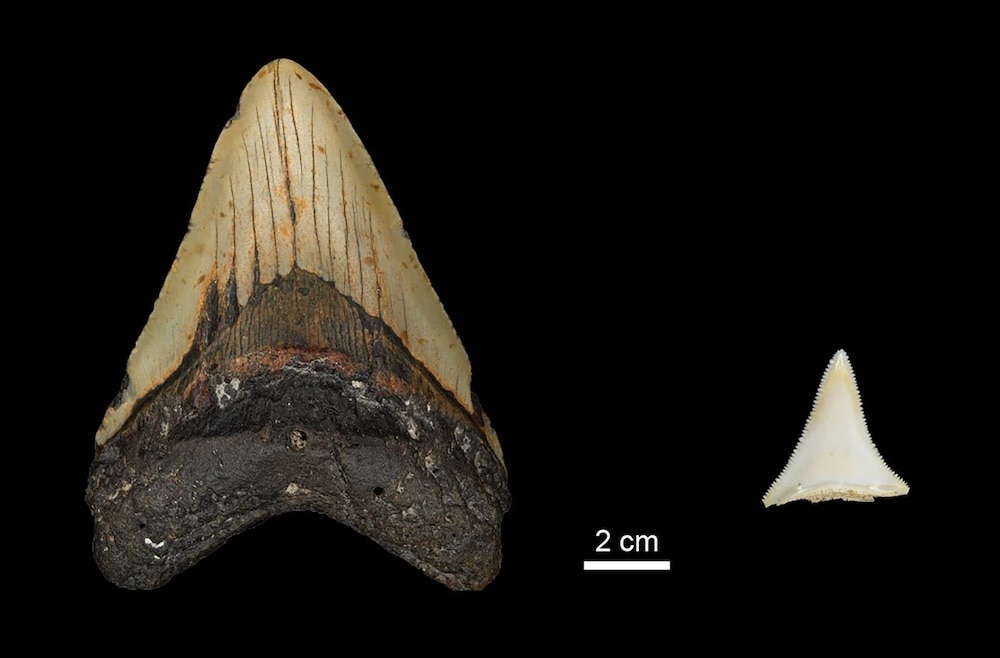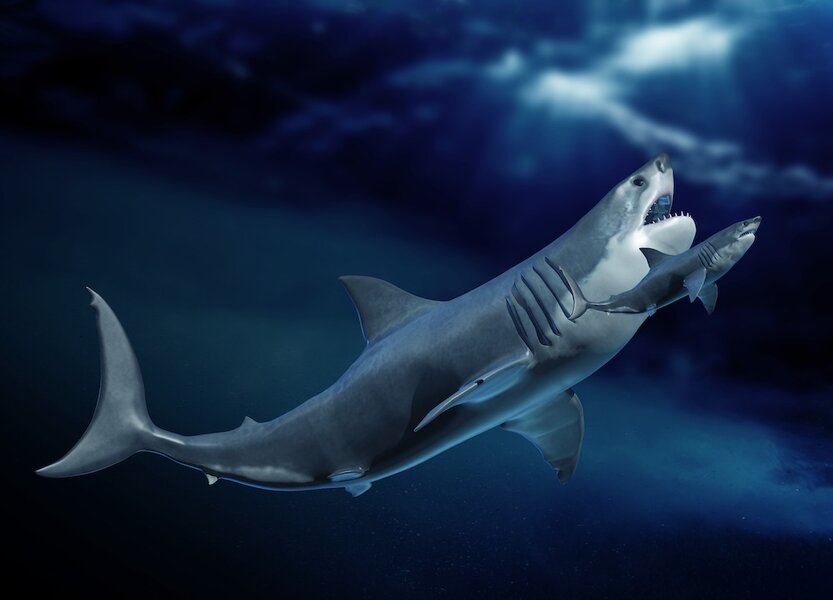Create a free profile to get unlimited access to exclusive videos, sweepstakes, and more!
Great whites might have pushed megalodons toward extinction
There was literally not enough food in the ocean for both of them.

There’s only one creature beautiful and terrifying enough to inspire countless nightmares, make Steven Spielberg a household name, and earn an entire week of dedicated programming on the Discovery Channel: the great white shark.
While there are only an estimated 3,500 great whites in the world’s oceans, it’s difficult to jump into the water without imagining there’s one lurking just beneath you. They are such effective apex predators they have conquered not just the oceans but our minds. Before great whites were the terror of the deep, however, there was another. A few million years ago megalodons patrolled the oceans, gobbling up seals and whales like handfuls of popcorn.
While they make great whites look like toddlers in comparison, it’s possible the smaller — yet still large — sharks contributed to the extinction of megalodons, as a result of resource competition. Jeremy McCormack, a geoscientist from the Goethe-University of Frankfurt, Germany and the Pax Planck Institute for Evolutionary Anthropology in Leipzig, Germany, along with colleagues, studied the fossil tooth remnants of extinct megalodons and ancient great whites in hopes of learning more about how they might have interacted millions of years ago. Their findings were published in the journal Nature Communications.
"It is difficult to reconstruct the diet of extinct animals, especially on timescales for which traditional dietary isotope proxies such as nitrogen isotopes in bone collagen are no longer applicable. That is because the collagen of bones and tooth dentine is degraded and no longer available when analyzing millions of years old animal remains," McCormack told SYFY WIRE. "Shark teeth are the most abundant vertebrate remains in the fossil record, because they are continuously regrown and shed. Additionally, sharks occupy several trophic levels and can have diverse diets. They are thus the ideal study material to investigate deep-time dietary proxies. We wanted to see if the original dietary zinc isotope signal is preserved over millions of years. It is.”
Megalodons first appeared on the scene about 23 million years ago and vanished sometime between 3.5 and 2.6 million years ago, right around the time when great white sharks showed up. Looking at a comparison of the two, it’s difficult to imagine that they might have been in competition with one another. We know who we’d put our money down on in a fair fight, but evolution is a complex dance and there’s no question that the great whites won.
Previous hypotheses regarding the extinction of megalodon suggested that great whites might have outcompeted them for food sources like whales and seals — meaning they occupied the same trophic level — but it can be difficult to determine the dietary proclivities of animals which disappeared millions of years before we invented the scientific method. To get a handle on what great whites and megalodons might have been eating during the Pliocene, scientists turned to chemical markers left behind in their teeth.
“Zinc is incorporated into the mineral phase of teeth. We analyze the ratio of heavy zinc to light zinc in the teeth. Because this ratio of zinc isotopes changes in animals depending on their relative position in the food chain, we can infer their trophic level,” McCormack said.
If you’re a fan of seafood yourself, you may be familiar with how these chemical markers work, at least as it pertains to mercury. Generally speaking, aquatic animals acquire mercury with size and age. One way this happens is by consuming other aquatic animals. As a result, aquatic animals which are higher in the food chain, have higher levels of mercury in their tissues than those lower down. You can think of zinc in shark teeth similarly, only the process works in reverse.
Levels of zinc are relatively high at the bottom of the chain in plants and plant-eating fish, and those levels decrease as you move higher up the food chain. By measuring the level of zinc incorporated into fossilized shark teeth, scientists are able to determine where they lie in the food web. This new study found the levels of zinc to be comparable among megalodons and great whites, suggesting they occupied the same spot on the food chain and likely competed for resources. Couple that with the timing of the great white’s emergence and the extinction of megalodons and you’ve got a recipe for an usurper.
“Our new study shows that the dietary range of the early Pliocene great white shark appears, at least zinc isotopically, very similar to that of megalodon, indicating that our data do not contradict the competition hypothesis,” McCormack said.
As badly as some of us might want to see a megalodon in the flesh, it’s probably for the best. Going to the beach can be frightening enough without worrying about sharks that could swallow us whole without chewing. We’ll happily take our chances with Jaws.



























